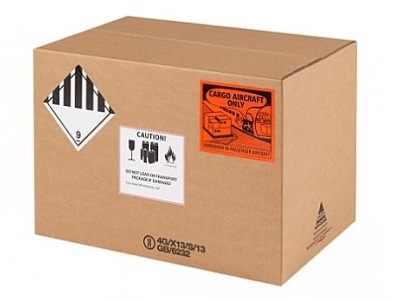IATA Dangerous Goods Regulations for the shipment of lithium-ion batteries by air

As the intro stated, in case of air transportation of your LiBs, you are required to meet the Dangerous Goods Regulations (DGR) issued by The International Air Transport Association, (IATA).
In order to summarize the regulations specifically for Lithium Batteries, IATA sells some good tools like the Lithium Battery Shipping Guidelines (LBSG) guide . The guide will take you through the shipping process step by step. You can also consult their Lithium Battery Guidance Document; it’s free of charge.
Below, I detail some of the requirements stated in the guidance document.
According to the register of Dangerous Goods in the DGR, Lithium-ion batteries are classified in Class 9 – Miscellaneous dangerous goods as either of:
UN 3480, Lithium-ion batteries
UN 3481, Lithium ion batteries contained in equipment; or
UN 3481, Lithium ion batteries packed with equipment.
This article focuses solely on shipping LiBs that are packed by themselves, therefore defined as UN3480. If we check out UN3480 in the register of dangerous goods in the DGR 58, we find that for this category, 8 special provisions and 1 packing instruction apply;
Special Provisions applicable to UN3480
A88: this provision details air shipment of lithium-ion battery prototypes
A99: lithium-ion batteries over 35 kilograms; these are to be approved by a national authority.
A154: lithium-ion batteries that are identified as defective for safety reasons or have been damaged, are forbidden for air transport
A164: an electrical battery that has the potential of dangerous evolution of heat, must be prepared for transport so that short circuit is prevented
A183: waste batteries (shipped for recycling) are forbidden from air transport unless approved by an appropriate national authority of the State of Origin of the transport, and the State of the operator responsible for transportation: the airline. So if you want to fly a waste battery from Germany on a Chinese aircraft, you need the approval of authorities in both states.
A201: As transportation of lithium-ion batteries on passenger aircrafts is basically prohibited, only cargo aircrafts may be used. This Special Provision regulates how a state — through its competent authority — can approve a deviation.
A206: this provision details the use of new and old version of hazard labels
A331: According to UN3480, “lithium-ion cells and batteries must be shipped at a state of charge (SoC) not exceeding 30% of their rated design capacity.” Exceptions can be made, however, according to special Provision A331. It states that with the approval of the State of Origin and the State of the Operator under the written conditions established by those authorities, deviating from the 30% maximum charge SoC can be allowed.
To compliantly ship LiBs by air, all packages must also be prepared in accordance with Packing Instruction 965.
So what exactly entails Packing Instruction 965? Let’s go over the specifics.
Packing Instruction 965 (PI965) to ship lithium-ion batteries by air
PI965 is divided into 3 sections, but also list some general requirements.
Largely seen this is — apart from the special provisions above — a demand to protect the batteries against any short circuit. There also is a general requirement that states that batteries are not to be over 30% SoC.
In each section, there are regulations about how a lithium-ion battery is supposed to be designed, tested and manufactured in order to use PI965. These can be found in a separate clause within IATA’s DGR: 3.9.2.6.
The 3 sections of Packing Instruction 965
1. Section IA; this is the regular requirement — it applies unless you can use one of the other sections with reduced requirements
2. Section IB; medium and fairly strict requirements for limited volumes of small LiBs
3. Section II; the lowest and less strict requirements for very small quantities of small LiBs
As you can see, section IA entails the most stringent requirements. If you want to ship just a couple of LiBs or smaller ones, you can work with Section IB and II, which have simplified regulations. In some cases, the regulations demand that you use UN-certified packaging.
Packing-Instruction:
UN3480 must comply with the packaging instructions of PI965,
and UN3481 must comply with the packaging instructions of PI966 (packed with Device)
or PI967 (lithium battery installed in Device)
UN-Number:
Lithium-ion battery: UN3480;
Lithium Ion Battery Installed in the Device and Lithium Ion Battery Packed with the Device: UN3481



